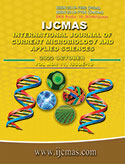


 National Academy of Agricultural Sciences (NAAS)
National Academy of Agricultural Sciences (NAAS)

|
PRINT ISSN : 2319-7692
Online ISSN : 2319-7706 Issues : 12 per year Publisher : Excellent Publishers Email : editorijcmas@gmail.com / submit@ijcmas.com Editor-in-chief: Dr.M.Prakash Index Copernicus ICV 2018: 95.39 NAAS RATING 2020: 5.38 |
Stethoscope harbours pathogenic microbes which can transmit to patients and health care workers. Disinfection of stethoscope can prevent this transmission and will reduce hospital acquired infections. Aim: To compare the bacterial contamination in personal stethoscope of doctors and ward stethoscopes which are disinfected routinely. Design: Single blinded study Methods and Material: A baseline culture was done on ward and personal stethoscopes. Ward stethoscopes were disinfected daily for four weeks and bacterial culture was done after each week. After four weeks, the bacterial contamination of ward and doctor’s stethoscope was compared. Results: In baseline culture, 22 stethoscopes (61%) had potential pathogenic microorganisms. After four weeks without any intervention, no considerable change was observed in the bacterial load and the pathogenic organisms cultured from personal stethoscopes. However, the bacterial load and the pathogenic organisms were markedly reduced in ward stethoscope after four weeks of disinfection. Conclusions: Stethoscopes harbours potentially pathogenic microorganisms and acts as a vector for transmission of HAIs among patients. This study proves that regular disinfection of stethoscope will reduce its bacterial contamination. Key-words: Stethoscope, Disinfection, Bacterial contamination, Hospital acquired infection, Non critical medical instruments. Key Messages: Hospital acquired infections can be greatly reduced if doctors follow disinfection of non-critical medical equipment when it is visibly soiled and on a regular basis.
John Albert, S. and Sujtha Elan Seranathan. 2022. Staphylococcus on your stethoscope?.
Int.J.Curr.Microbiol.App.Sci. 11(10): 207-211. doi: https://doi.org/10.20546/ijcmas.2022.1110.025 |
 |
 |
 |
 |